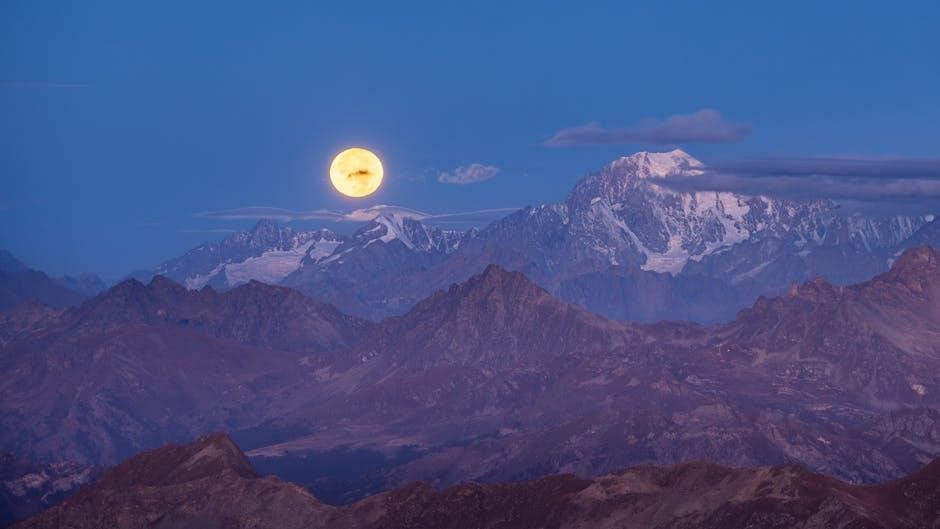Mont Blanc, the highest peak in the Alps, offers a thrilling ascent for adventurers. Climbing with a certified guide ensures safety, expertise, and a successful experience.
1.1. Overview of Mont Blanc
Mont Blanc, standing at 4,810 meters, is the highest peak in the Alps and a iconic destination for climbers. Known as the “Roof of Europe,” it offers breathtaking views and challenging ascents. Its snow-capped summit attracts adventurers worldwide, though its high altitude and unpredictable weather demand careful preparation and expert guidance for a safe and successful climb.
1.2. Why Choose a Guided Ascent?
A guided ascent ensures safety, expertise, and a higher likelihood of success. Certified guides provide in-depth knowledge of the terrain, weather conditions, and technical challenges. They assist with route selection, acclimatization, and equipment use, making the climb more manageable and enjoyable. Their experience is crucial for navigating Mont Blanc’s unpredictable environment and overcoming its demanding high-altitude conditions.

Routes for Mont Blanc Ascent
Mont Blanc offers several iconic routes, including the Goûter Route, the Three Mont Blanc Route, and the Historic Route via Grands Mulets, each providing unique challenges and breathtaking views.
2.1. The Goûter Route (Voie Royale)
The Goûter Route, or Voie Royale, is the most popular and straightforward path to Mont Blanc’s summit. Starting from the Nid d’Aigle, it involves a 1,400-meter ascent. The route combines snow and rock terrain, offering stunning views. Climbers typically stay at the Tête Rousse or Goûter refuges. The second day is more demanding, with a 1,400-meter climb to the summit and a challenging descent. Good physical condition is essential for this classic yet demanding route.
2.2. The Three Mont Blanc Route
The Three Mont Blanc Route offers a diverse and challenging ascent. It begins at the Cosmiques Hut, navigating through varied terrain. Climbers encounter steep rock passages, glaciers, and exposed ridges. This route is less crowded than the Goûter Route but requires technical skills. The summit day involves a 1,400-meter climb, with breathtaking views of the Alps. Proper acclimatization and a guide are recommended for a safe experience.
2.3. The Historic Route via Grands Mulets
The Historic Route via Grands Mulets is a classic ascent offering stunning views of glaciers and high peaks. Starting from Chamonix, the route passes through Plan de l’Aiguille and the Grands Mulets refuge. It combines glacier travel with a steep climb to the summit. This route is less crowded than others but demands good physical fitness and basic mountaineering skills for a successful climb.

Importance of a Mountain Guide
A certified mountain guide ensures safety, shares expertise, and maximizes chances of a successful ascent. Their knowledge of routes, conditions, and risks is invaluable for a secure experience.
3.1. Safety and Expertise
A certified mountain guide ensures safety and expertise, managing risks like crevasses and avalanches. Their extensive knowledge of Mont Blanc’s terrain and weather conditions minimizes hazards, ensuring a secure ascent.
3.2. Historical First Ascents
The first ascent of Mont Blanc in 1786 by Jacques Balmat and Michel Paccard marked a historic milestone. This achievement demonstrated the importance of guides in high-altitude expeditions, setting the foundation for modern guiding practices.
3.3. Modern Guiding Techniques
Modern guides employ advanced techniques, including personalized acclimatization plans and real-time weather analysis, ensuring safer and more efficient ascents. They use cutting-edge equipment and focus on client-specific physical conditioning to maximize success rates while maintaining high safety standards.
Preparation for the Ascent
Preparation involves acclimatization to high altitudes, reviewing technical skills like crampon use, and ensuring physical fitness to handle the climb’s demands effectively and safely.
4.1. Acclimatization Period
A mandatory acclimatization period is crucial before attempting Mont Blanc. This phase allows climbers to adapt to high altitudes, reducing risks of altitude sickness. Guides often include hikes to lower peaks and glacier training, ensuring climbers are well-prepared for the ascent. Proper acclimatization enhances both safety and the likelihood of a successful summit.
4.2. Technical Skills Review
A thorough review of technical skills is essential for a safe Mont Blanc ascent. Climbers must master crampon techniques, ice axe handling, and rope work. Glacier travel and crevasse rescue methods are also critical. Guides ensure proficiency in these areas, adapting training to individual needs and prior experience, to build confidence and competence for the challenging climb ahead.
4.3. Physical Conditioning
Excellent physical fitness is crucial for Mont Blanc ascent due to its demanding nature. Climbers need strong endurance for long days at high altitudes. Regular cardiovascular exercises like trail running or cycling are recommended. Building muscular endurance through strength training is also essential to handle the climb’s physical demands effectively and safely.

Day-by-Day Itinerary
The classic 3-day journey starts at Les Houches, ascending to Tête Rousse on Day 1. Day 2 involves summiting Mont Blanc via the Gouter Refuge. Day 3 concludes with descent back to Les Houches, ensuring a well-structured and safe experience with proper acclimatization and physical effort.
5.1. Day 1: Les Houches to Tête Rousse
Begin at Les Houches, taking the Mont Blanc Tramway to Nid d’Aigle. Hike 2 hours to Refuge de Tête Rousse, elevation 3,167m. Acclimatize and overnight here, preparing for the summit push ahead.
5.2. Day 2: Tête Rousse to Mont Blanc Summit
Depart early from Tête Rousse Refuge. Navigate technical sections, including rocky terrain and snowfields, reaching the summit of Mont Blanc (4,810m). Descend to Refuge du Gouter for a well-deserved rest and overnight stay, reflecting on the achievement.
5.3. Day 3: Descent to Les Houches
Begin the descent from Refuge du Gouter, retracing the route via Tête Rousse. Continue downhill to the Nid d’Aigle, where the cable car and train await for the return to Les Houches. This final leg completes the loop, marking the end of an unforgettable Mont Blanc ascent. The journey home begins with lasting memories.
Equipment and Gear
Essential gear includes crampons, ice axes, sturdy boots, and layered clothing. Rental options are available for technical equipment, ensuring climbers have proper gear for a safe ascent.
6.1. Essential Gear List
Your gear list should include crampons, ice axes, and sturdy mountaineering boots. Layered clothing, gloves, and a warm hat are crucial for cold conditions. Additionally, bring a first-aid kit, headlamp, and navigation tools. Renting equipment like ropes and harnesses is advisable if you lack experience. Always consult with your guide to ensure you have the right gear for a safe ascent.
6.2. Rental Options
Renting equipment is a convenient option for climbers. Local shops offer high-quality rentals, including crampons, ice axes, and boots. Guides often collaborate with these shops to ensure proper fit and equipment suitability. Renting avoids transporting bulky gear and guarantees access to gear tailored to Mont Blanc’s conditions. Check with your guide service for recommendations and availability.

Weather and Mountain Conditions
Mont Blanc’s weather is notoriously unpredictable. Climbers face high-altitude conditions, including snow, ice, and strong winds. Guides monitor these factors to ensure a safe and successful ascent.
7.1. Understanding High-Altitude Weather
High-altitude weather on Mont Blanc is unpredictable and extreme, with rapid temperature shifts, strong winds, and potential snowstorms. Climbers must monitor forecasts and adapt to changing conditions to ensure safety. Guides play a crucial role in assessing weather risks and making informed decisions to secure a successful ascent without compromising safety.
7.2. Navigation and Safety Measures
Navigation on Mont Blanc requires precision, using GPS and compass to stay on route. Safety measures include rope techniques, emergency protocols, and adapting to changing weather. Climbers must remain vigilant, ensuring proper equipment use and communication. Guides play a pivotal role in assessing risks and making informed decisions to ensure a secure ascent.

Physical Condition Requirements
A strong physical condition is essential for Mont Blanc ascent. Climbers need stamina, endurance, and good cardiovascular health to tackle the mountain’s demanding terrain and high altitude successfully.
8.1. Fitness Levels
A high level of physical fitness is crucial for Mont Blanc ascent. Climbers need strong stamina, endurance, and cardiovascular health to handle steep climbs, long hikes, and glacier traversals. Prior experience with high-altitude trekking or mountaineering is beneficial, as the ascent demands sustained effort over multiple days at elevated altitudes.
8.2. Health Considerations
Good overall health is essential for a Mont Blanc ascent. Climbers must ensure they have no medical conditions that could worsen at high altitudes. Acclimatization is crucial to prevent altitude sickness. Consulting a doctor before the climb is recommended, especially for those with pre-existing health issues. Guides also assess participants’ health to ensure safe participation.
Booking and Reservations
Reservations for Mont Blanc ascents should be made early due to limited refuge spots. Booking with certified guides ensures secure arrangements and adherence to cancellation policies.
9.1. Refuge and Guide Booking
Booking refuges and guides early is essential due to limited availability. Certified guides guarantee secure reservations, providing equipment and ensuring safety. Packages often include meals and accommodations, optimizing your ascent experience.
9.2. Cancellation Policies
Refuge and guide bookings have strict cancellation policies due to limited availability. Refunds are typically offered for cancellations made well in advance, but fees may apply. Ensure flexibility by reviewing policies before booking. Some guides offer insurance options to protect against unforeseen cancellations. Secure bookings early to avoid losing deposits.
Climbing Mont Blanc is a rewarding experience requiring preparation, physical fitness, and expert guidance. With proper planning and a certified guide, you can safely conquer Europe’s highest peak and cherish the breathtaking views forever.
10.1. Final Tips for Success
Ensure proper acclimatization, hire a certified guide, and maintain excellent physical condition. Pack essential gear, stay flexible with weather changes, and remain mentally prepared for the challenging ascent. Proper planning and adherence to safety protocols will maximize your chances of a successful and enjoyable Mont Blanc climb.
